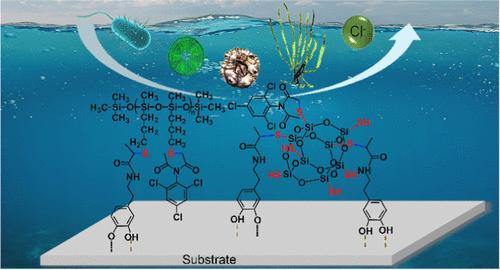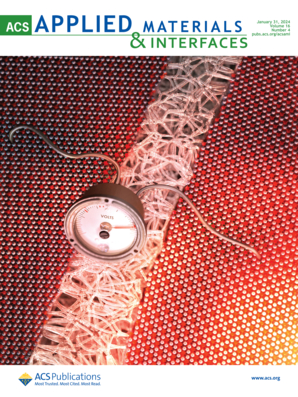光引发的硫醇-烯键合反应制备船舶防污防腐蚀用高粘接、机械稳定的有机硅涂料
IF 8.3
2区 材料科学
Q1 MATERIALS SCIENCE, MULTIDISCIPLINARY
引用次数: 0
摘要
海洋生物污染和腐蚀已成为影响海洋工业发展的主要问题。硅基涂料因其表面能低而广泛应用于防污和防腐领域。然而,这些材料的附着力差,机械稳定性低,限制了它们在复杂海洋环境中的应用。本文通过光引发硫醇烯与(巯基丙基)甲基硅氧烷二甲基硅氧烷(PDMS-SH)、多巴胺甲基丙烯酰胺(DMA)、巯基功能化有机硅氧烷(POSS-(SH)8)和N-(2,4,6-三氯苯基)马来酰亚胺(TCM)结合反应制备了一种海洋防污防腐涂料POSS-DMA@PDMS-TCM。当DMA含量为3 wt %时,POSS-DMA@PDMS-TCM涂层在空气(2.17 MPa)和水下(2.11 MPa)均表现出较强的稳定性和结合能力。对金黄色葡萄球菌的抑菌率为98.1%,对大肠杆菌的抑菌率为99.5%,对硅藻的抑菌率为94.5%。此外,在120天的海上现场测试中,POSS-DMA@PDMS-TCM涂层表现出优异的防污能力,与空白组相比,减少了65.5%的污垢。该涂层对Cu的Ecorr值为−0.055 V, Icorr值为7.67 × 10-6, Rp值为3.10 × 105 Ω,具有良好的螯合作用和驱液性。本研究为开发高质量的船舶防污防腐蚀涂料提供了新的思路。本文章由计算机程序翻译,如有差异,请以英文原文为准。

Photoinitiated Thiol–Ene Click Reaction for Preparation of Highly Adhesive and Mechanically Stable Silicone Coatings for Marine Antifouling and Anticorrosion
Marine biofouling and corrosion have become the main problems affecting the development of the marine industry. Silicone-based coatings have been widely used for antifouling and anticorrosion due to their low surface energy. However, the poor adhesion and low mechanical stability of these materials limit their application in complex marine environments. In this work, we presented a marine antifouling and anticorrosion coating named POSS-DMA@PDMS-TCM through photoinitiated thiol–ene click reaction combined with (mercaptopropyl) methylsiloxane dimethylsiloxane (PDMS-SH), dopamine methacrylamide (DMA), sulfhydryl-functionalized organosiloxanes (POSS-(SH)8), and N-(2,4,6-trichlorophenyl) maleimide (TCM). The POSS-DMA@PDMS-TCM coating exhibited strong stability and bonding ability both in air (2.17 MPa) and underwater (2.11 MPa) when the DMA content was 3 wt %. The high antibacterial (98.1% for Staphylococcus aureus and 99.5% for Escherichia coli) and antidiatom (94.5%) properties of the POSS-DMA@PDMS-TCM coatings have also been confirmed. Moreover, the POSS-DMA@PDMS-TCM coatings show excellent antifouling abilities in 120-day marine field tests, reducing fouling by 65.5% in comparison to the blank group. The coating also displayed superior anticorrosion performance with Ecorr values of −0.055 V, Icorr values of 7.67 × 10–6 , and Rp values of 3.10 × 105 Ω for Cu, which benefited from excellent chelating effect and liquid repellency. This study provides a novel strategy for the development of high-quality marine antifouling and anticorrosion coatings.
求助全文
通过发布文献求助,成功后即可免费获取论文全文。
去求助
来源期刊

ACS Applied Materials & Interfaces
工程技术-材料科学:综合
CiteScore
16.00
自引率
6.30%
发文量
4978
审稿时长
1.8 months
期刊介绍:
ACS Applied Materials & Interfaces is a leading interdisciplinary journal that brings together chemists, engineers, physicists, and biologists to explore the development and utilization of newly-discovered materials and interfacial processes for specific applications. Our journal has experienced remarkable growth since its establishment in 2009, both in terms of the number of articles published and the impact of the research showcased. We are proud to foster a truly global community, with the majority of published articles originating from outside the United States, reflecting the rapid growth of applied research worldwide.
 求助内容:
求助内容: 应助结果提醒方式:
应助结果提醒方式:


